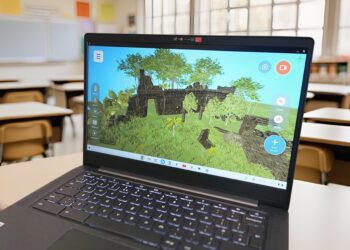As educators, it is our role to create an environment conducive to high student engagement. In my classroom, one way I have learned to maintain student interest in a subject is by putting them in the driver’s seat.
Developing quality STEM projects requires an investment from the student in their learning. By giving students ownership of the content, they’ll be more motivated to learn.
Rather than asking students to memorize abstract concepts, STEM-based projects allow students to solve problems in the context of the real world. Using real-world problems answers the commonly asked question, “Why is this important, especially if I can Google it?” However, as educators embarking on a new way to approach lessons, we have to reverse our ways of planning with the end in mind. STEM-based projects cannot be planned in a traditional format where teachers have a specific end goal for students to reach. I have discovered that learning with STEM is a journey, and it cannot be confined to preconceived barriers.
When launching a quality STEM project, consider the following four components.
Find ready-to-use STEM activities and resources in your daily learning platform!
1. A Driving Question
What part of our curricula is most attractive to our students? This answer will be different depending on each and every student. Structuring the lesson around a driving question will direct the path of your students’ learning. A driving question can be around a real world phenomenon or a topic which students have some knowledge of, but want to explore further. Some driving questions I have used in my classroom include, “How have human choices impacted the environment?” and “How can we help reverse the effects of pollution on our local environment?”
2. Solve A Problem
Problem-based learning creates a context for students to relate their knowledge to the problems of the real world. Solving a problem helps to instill a confidence in students that they can impact change. I have found this success is incredibly rewarding to students. It piques their interest and cultivates curiosity in the solutions to other real-world problems.
3. Opportunities to Redesign
Teaching and learning with a question in mind takes patience and effort. Students need opportunities and time to process feedback and use the feedback to reflect, revise, and refine their work. This cycle will highlight areas that can be improved through redesign. For example, I have former students tasked with designing rain barrel models to help conserve water and limit runoff pollution. After building their initial model, students tested their model with water. Several groups noted some leaky areas and used this evidence to redesign the next version of their rain barrel model.
4. Multiple Assessment Methods
Driving questions lend themselves to a variety of assessment methods. One student’s findings may be represented using a Google Slides presentation, while another student may need to create a physical model to explain his work. In an increasingly digitally dependent world, many students are more engaged and comfortable with using digital technology to share their knowledge. Both methods are acceptable as long as the same criteria for success are used to assess each project.
A sample criteria for success may be:
- The project accurately and appropriately answers the driving question.
- The project shows deep understanding of the unit concept.
- The project includes a minimum of two cited research sources.
A driving question hooks your students and pulls their learning into a real world format. STEM projects facilitate connections to be made in the journey of learning rather than at the beginning or end of an instructional sequence. This sense of ownership helps to build the 21st century learners that are leading our future.
About the Author
Ginger Berry is a middle school teacher in Montgomery County Public Schools.






